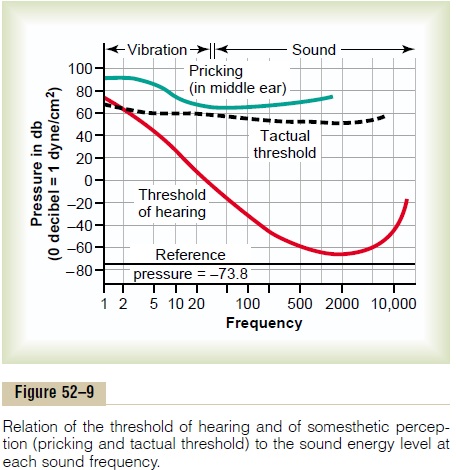Chapter: Medical Physiology: The Sense of Hearing
Determination of Loudness
Determination of Loudness
Loudness is determined by the auditory system in at least three ways.
First, as the sound becomes louder, the amplitude of vibration of the basilar membrane and hair cells also increases, so that the hair cells excite the nerve endings at more rapid rates.
Second, as the amplitude of vibration increases, it causes more and more of the hair cells on the fringes of the resonating portion of the basilar membrane to become stimulated, thus causing spatial summation of impulses—that is, transmission through many nerve fibers rather than through only a few.
Third, the outer hair cells do not become stimulated significantly until vibration of the basilar membrane reaches high intensity, and stimulation of these cells presumably apprises the nervous system that the sound is loud.
Detection of Changesin Loudness—The Power Law. As pointed out, a person interprets changes in intensity of sensory stimuli approximately in pro-portion to an inverse power function of the actual intensity. In the case of sound, the interpreted sensa-tion changes approximately in proportion to the cube root of the actual sound intensity. To express this another way, the ear can discriminate differences in sound intensity from the softest whisper to the loudest possible noise, representing an approximately 1 trilliontimes increase in sound energy or 1 million timesincrease in amplitude of movement of the basilar membrane. Yet the ear interprets this much difference in sound level as approximately a 10,000-fold change. Thus, the scale of intensity is greatly “compressed” by the sound perception mechanisms of the auditory system. This allows a person to interpret differences in sound intensities over an extremely wide range—a far wider range than would be possible were it not for compression of the intensity scale.
Decibel Unit. Because of the extreme changes in soundintensities that the ear can detect and discriminate, sound intensities are usually expressed in terms of the logarithm of their actual intensities. A 10-fold increase in sound energy is called 1 bel, and 0.1 bel is called 1decibel. One decibel represents an actual increase insound energy of 1.26 times.
Another reason for using the decibel system to express changes in loudness is that, in the usual sound intensity range for communication, the ears can barely distinguish an approximately 1-decibel change in sound intensity.
Threshold for Hearing Sound at Different Frequencies. Figure52–9 shows the pressure thresholds at which sounds of different frequencies can barely be heard by the ear. This figure demonstrates that a 3000-cycle-per-second sound can be heard even when its intensity is as low as 70 decibels below 1 dyne/cm2 sound pressure level, which is one ten-millionth microwatt per square cen-timeter. Conversely, a 100-cycle-per-second sound can be detected only if its intensity is 10,000 times as great as this.
Frequency Range of Hearing. The frequencies of sound thata young person can hear are between 20 and 20,000 cycles per second. However, referring again to Figure 52–9, we see that the sound range depends to a great extent on loudness. If the loudness is 60 decibels below 1 dyne/cm2 sound pressure level, the sound range is 500

to 5000 cycles per second; only with intense sounds can the complete range of 20 to 20,000 cycles be achieved. In old age, this frequency range is usually shortened to 50 to 8000 cycles per second or less, as discussed later.
Related Topics